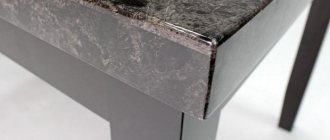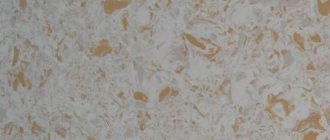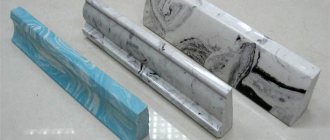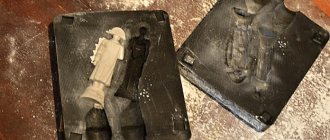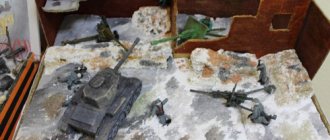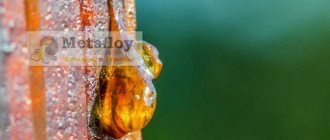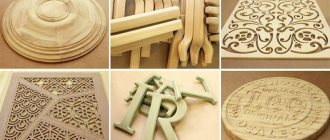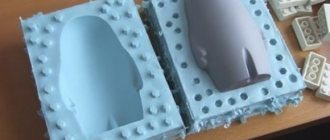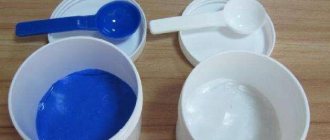Products that imitate natural stones have high strength, resistance to chemicals, environmental friendliness, shock and heat resistance, as well as other advantages. Artificial marble is made from concrete, gypsum and polyester resin and is used not only for cladding houses, but also in the manufacture of countertops, stairs, window sills, fountains and much more.
To make artificial marble with your own hands, you need to decide on the technology for its production.
Description and types of material
Artificial marble is a decorative and building material that quite accurately imitates natural stone. It is widely used in construction, renovation and industrial applications.
For its production, both mineral components and synthetic resins and other additives are used. Due to the special method of introducing dyes, the surface of the finished product has a characteristic pattern with marble stains and specks.
Artificial marble has many positive characteristics:
- high mechanical strength;
- durability, long period of operation;
- low thermal and electrical conductivity;
- fire safety;
- environmental friendliness, harmlessness;
- resistance to acids, alkalis, fats, moisture;
- aesthetic appearance;
- hardness, ease of processing.
Depending on the production method, artificial marble can be cast, cast, ground or liquid.
Liteva
This composite material is the most popular, since the injection molding method is applicable even at home. The basis of artificial marble is a mineral filler (quartz sand or stone chips) and polyester resin. In industry, plasticizers and other targeted additives are also added to the composition.
Oselkovy
The material is a marble-painted gypsum mass, which is diluted with an adhesive solution. Substances that slow down the setting of gypsum must be added to the composition. Due to grinding and polishing, products made from ashlar marble have a beautiful shine. They turn out durable and lightweight.
Oselok marble slabs
Important! Products made from oselkov marble do not tolerate high humidity.
Ground (microcalcite)
Crushed (ground) marble is a white, grayish powdery material obtained by grinding marble chips. It is used for the production of paints and varnishes, linoleum, and various types of plastic. Finished products are durable and resistant to UV radiation, but their moisture resistance is quite low.
Liquid
The material is produced by combining marble chips and acrylic polymers. It is lightweight, flexible, completely non-toxic and environmentally friendly. Due to their small thickness, sheets of liquid artificial marble can be cut with scissors and used instead of wallpaper. The surface will be smooth, seamless and durable.
Production of cast artificial marble
Before starting work, you need to immediately prepare all materials and consumables, as well as buy or rent tools and equipment for marble production.
Equipment
First of all, you need matrices - forms for pouring the marble mixture. Polyurethane molds have proven themselves best - they are very durable and do not deform, although they are not cheap.
Table top mold
You will also need:
- components for mixing the composition;
- construction mixer;
- Sander;
- capacity;
- gelcoat sprayer or mold brushes.
Composition of raw materials
The main components are polyester resin (gelcoat) and marble chips (flour) in a 4:1 ratio. Cement, gypsum, lime, and quartz sand are also used to improve strength and improve performance characteristics.
Important! If desired, cement can completely replace the polyester resin in the composition, but the reliability of the finished marble will decrease.
In this case, the “recipe” for the solution will be as follows:
- sand – 2 parts;
- cement – 1 part;
- small stone chips – 25% of the total volume;
- water – 0.2 parts;
- plasticizer – 1% by weight of cement;
- pigment – 1% by weight of cement.
Production technology
The method of producing artificial marble is simple, it is only important to follow the specified recommendations.
Preparation of the solution
Pour the dry ingredients into a clean container, mix them thoroughly with a mixer and add the dye. The latter is mixed in carefully to maintain the uneven color of the finished material.
Then the mass is diluted with water, shaken well or placed on a vibrating table - this will help get rid of air bubbles. Water is introduced in 2 steps: first, 80% of the liquid is added, then the plasticizer is added, and then the remaining water.
Preparation and filling of forms
The molds are placed in a strictly horizontal position, sprayed with gelcoat (polyester resin), and the solution is poured. Shake to get rid of excess air and leave to harden for at least a day under the film.
Advice! To enhance the strength of marble, reinforcement is made - a wire mesh is placed in the thickness of the solution.
Processing of finished slabs
After curing, the molds are turned over, the stone slabs are taken out and sanding begins. Such products can only be cut with equipment equipped with diamond blades.
Business organization
Organizing a business for the production of artificial marble, in principle, is no different from opening any other enterprise, and includes the following main stages:
| Stage name | Condition to be fulfilled | Deadline |
| Business registration, preparation of necessary documents | availability of a package of necessary documents | 1 month |
| Selection and arrangement of premises | 1 month | |
| Purchase and installation of necessary equipment | availability of funds | 1 month |
| Manufacturing process | fulfillment of previous conditions | throughout the entire working period |
| Implementation of marketing policy | throughout the entire working period |
We recommend reading:
- Lego brick production
- production of paving slabs
- production of expanded clay blocks
- production of arbolite blocks
- production of dry construction mixtures
Necessary equipment
All the necessary tools and equipment for making marble with your own hands can be purchased at any hardware store. You will have to specially order only molds for marble. You will need:
- polyurethane molds;
- polyethylene film for covering products;
- concrete mixer;
- vibrating table;
- brush;
- shovels;
- measuring devices and scales for precise dosage of plasticizer and coloring pigments;
- angle grinder (“grinder”);
- special cutting wheels for grinders for working with stone;
- grinding attachments.
For small production volumes, you can reduce costs by dispensing with a mixer. You can make a vibrating table yourself, reducing its cost three times compared to the price tag in the store. Consumables include:
- construction wax and gelcoat;
- sand;
- cement;
- pebbles or crushed stone;
- plasticizer;
- coloring matter.
Manufacturing facility
Installing all the necessary equipment will not take up much space. It is quite possible to use an ordinary garage as a production facility. What other business ideas can be implemented in a garage can be found at this link. However, you will also need a place for drying and storing the finished material.
Staff
The entire production process can be completed by just one person, but it is still better to work together. It is not at all necessary to hire a hired employee for this. It is advisable to organize an enterprise for the production of artificial marble with the help of one family. Additional labor will be needed only as a result of business expansion - after its promotion and the appearance of a large number of orders.
Business registration
Registering a business is possible both as an LLC and as an individual entrepreneur - there is no fundamental difference here. Therefore, the main criterion when determining the form of doing business will be the choice of the most favorable tax regime.
More information about choosing a tax payment system can be found here. All the necessary information about what taxes an individual entrepreneur pays is in this source. In addition to the standard package of documents to register your business, you will need to obtain a certificate of conformity for your products and a conclusion from Rospotrebnadzor on their quality and safety for the consumer.
We recommend reading:
- business for the production of laminated veneer lumber –
- production of fiberglass reinforcement –
- production of plastic pipes –
Use and care instructions
Artificial marble is often used for decorating rooms and wall cladding. It makes beautiful tabletops, window sills, stairs, sculptures, and decorative fountains. The material is suitable for finishing house facades, emphasizing window and door openings, and creating paving slabs.
Artificial marble should be cleaned with a soft cloth, as hard brushes can leave scratches on it. It is washed using liquid SMS and does not use drying oil-based products for polishing. Otherwise, the material is considered quite unpretentious and, with the right approach, will last for many years.
The procedure for making the mold
In order to start working on making a mold, you need to determine:
- will the matrix be used once or will it be used multiple times. If it is necessary to use the matrix several times, its design must be made collapsible;
- the necessary strength that can be achieved when preparing the mixture;
- view of the front surface. It can be smooth or grooved. Often, the grooved look is suitable for making wall tiles.
A variety of materials can be used to make the matrix; there are no restrictions. The main requirement is the strength of the matrix and ease of working with it. Most often it is created on the basis of gypsum, polyurethane, plastic, and wood. In the event that the matrix is quite large, and the final product must be smaller in size, the mold can be divided into half-molds. Thus, samples of the same type will be produced, and the work will represent mass production.
How to prepare a matrix
To prepare the matrix for sample production, it is necessary to lubricate the internal surface with a lubricant, thus preventing the mixture from sticking to the walls of the matrix. If the resulting marble is planned to be processed in the future, a thin polyethylene film can also be used as a separator. The surface of the sample is lubricated with gel, which gives it the necessary shine.
Preparing the batch
The basic rule used when preparing a batch is to obtain a homogeneous mass. This result can only be achieved by thoroughly mixing all components. To facilitate manual labor, you can use electrical appliances such as a construction mixer or drill.
Pouring the mixture
When the solution is poured into the matrix, it is necessary to remove air from it, which appears in the form of bubbles. It is easier to do this by piercing the solution along the entire perimeter of the matrix. Those who are not producing cast marble for the first time may have already purchased a vibrating table, the operation of which allows you to rid the mixture of air layers.
The rate of hardening of marble depends on the air temperature, the thickness of the load and the components of the mixture. Minimum time 30 minutes, maximum 12 hours. At this stage, it should be remembered that the mass should not be completely poured into the matrix at one time; filling the matrix is carried out in several stages and is accompanied by constant stirring. When the entire mass is loaded, the matrix is covered with a film on top, which prevents cracks from appearing on the sample and prevents moisture from evaporating.
Post-processing
Removal of the sample from the matrix is accompanied by a decision on the need for additional mechanical processing and final polishing.
